#iOS Design Patterns
Explore tagged Tumblr posts
Text
0 notes
Text
Understanding the Decorator Pattern in Swift: A Practical Example
Overview Design patterns are a cornerstone of software development, providing reusable solutions to common problems. The Decorator Pattern is a structural design pattern that allows you to dynamically add new behavior to objects without altering their structure. It follows the Open/Closed Principle, which states that a class should be open for extension but closed for modification. In this…
0 notes
Text
Learn about the relevance of mobile app design patterns from Intileo Technologies, is a leading mobile app development company India. Apps that follow design patterns such as navigation bars, input forms, and interactive buttons are more user-friendly. Intileo Technologies excels at creating intuitive designs that improve user experience, distinguishing us as leaders in mobile app development in India. Trust us to bring your app ideas to life with our experienced design and development services.
#app development agency in india#best app development company in india#custom web app development services#iphone app development company#mobile app development services india#ios app development company india#ecommerce app development company#mobile app development company india#Mobile App Design Patterns
0 notes
Text
Are the means of computation even seizable?

I'm on a 20+ city book tour for my new novel PICKS AND SHOVELS. Catch me in PITTSBURGH in TOMORROW (May 15) at WHITE WHALE BOOKS, and in PDX on Jun 20 at BARNES AND NOBLE with BUNNIE HUANG. More tour dates (London, Manchester) here.

Something's very different in tech. Once upon a time, every bad choice by tech companies – taking away features, locking out mods or plugins, nerfing the API – was countered, nearly instantaneously, by someone writing a program that overrode that choice.
Bad clients would be muscled aside by third-party clients. Locked bootloaders would be hacked and replaced. Code that confirmed you were using OEM parts, consumables or adapters would be found and nuked from orbit. Weak APIs would be replaced with muscular, unofficial APIs built out of unstoppable scrapers running on headless machines in some data-center. Every time some tech company erected a 10-foot enshittifying fence, someone would show up with an 11-foot disenshittifying ladder.
Those 11-foot ladders represented the power of interoperability, the inescapable bounty of the Turing-complete, universal von Neumann machine, which, by definition, is capable of running every valid program. Specifically, they represented the power of adversarial interoperability – when someone modifies a technology against its manufacturer's wishes. Adversarial interoperability is the origin story of today's tech giants, from Microsoft to Apple to Google:
https://www.eff.org/deeplinks/2019/10/adversarial-interoperability
But adversarial interop has been in steady decline for the past quarter-century. These big companies moved fast and broke things, but no one is returning the favor. If you ask the companies what changed, they'll just smirk and say that they're better at security than the incumbents they disrupted. The reason no one's hacked up a third-party iOS App Store is that Apple's security team is just so fucking 1337 that no one can break their shit.
I think this is nonsense. I think that what's really going on is that we've made it possible for companies to design their technologies in such a way that any attempt at adversarial interop is illegal.
"Anticircumvention" laws like Section 1201 of the 1998 Digital Millennium Copyright Act make bypassing any kind of digital lock (AKA "Digital Rights Management" or "DRM") very illegal. Under DMCA, just talking about how to remove a digital lock can land you in prison for 5 years. I tell the story of this law's passage in "Understood: Who Broke the Internet," my new podcast series for the CBC:
https://pluralistic.net/2025/05/08/who-broke-the-internet/#bruce-lehman
For a quarter century, tech companies have aggressively lobbied and litigated to expand the scope of anticircumvention laws. At the same time, companies have come up with a million ways to wrap their products in digital locks that are a crime to break.
Digital locks let Chamberlain, a garage-door opener monopolist block all third-party garage-door apps. Then, Chamberlain stuck ads in its app, so you have to watch an ad to open your garage-door:
https://pluralistic.net/2023/11/09/lead-me-not-into-temptation/#chamberlain
Digital locks let John Deere block third-party repair of its tractors:
https://pluralistic.net/2022/05/08/about-those-kill-switched-ukrainian-tractors/
And they let Apple block third-party repair of iPhones:
https://pluralistic.net/2022/05/22/apples-cement-overshoes/
These companies built 11-foot ladders to get over their competitors' 10-foot walls, and then they kicked the ladder away. Once they were secure atop their walls, they committed enshittifying sins their fallen adversaries could only dream of.
I've been campaigning to abolish anticircumvention laws for the past quarter-century, and I've noticed a curious pattern. Whenever these companies stand to lose their legal protections, they freak out and spend vast fortunes to keep those protections intact. That's weird, because it strongly implies that their locks don't work. A lock that works works, whether or not it's illegal to break that lock. The reason Signal encryption works is that it's working encryption. The legal status of breaking Signal's encryption has nothing to do with whether it works. If Signal's encryption was full of technical flaws but it was illegal to point those flaws out, you'd be crazy to trust Signal.
Signal does get involved in legal fights, of course, but the fights it gets into are ones that require Signal to introduce defects in its encryption – not fights over whether it is legal to disclose flaws in Signal or exploit them:
https://pluralistic.net/2023/03/05/theyre-still-trying-to-ban-cryptography/
But tech companies that rely on digital locks manifestly act like their locks don't work and they know it. When the tech and content giants bullied the W3C into building DRM into 2 billion users' browsers, they categorically rejected any proposal to limit their ability to destroy the lives of people who broke that DRM, even if it was only to add accessibility or privacy to video:
https://www.eff.org/deeplinks/2017/09/open-letter-w3c-director-ceo-team-and-membership
The thing is, if the lock works, you don't need the legal right to destroy the lives of people who find its flaws, because it works.
Do digital locks work? Can they work? I think the answer to both questions is a resounding no. The design theory of a digital lock is that I can provide you with an encrypted file that your computer has the keys to. Your computer will access those keys to decrypt or sign a file, but only under the circumstances that I have specified. Like, you can install an app when it comes from my app store, but not when it comes from a third party. Or you can play back a video in one kind of browser window, but not in another one. For this to work, your computer has to hide a cryptographic key from you, inside a device you own and control. As I pointed out more than a decade ago, this is a fool's errand:
https://memex.craphound.com/2012/01/10/lockdown-the-coming-war-on-general-purpose-computing/
After all, you or I might not have the knowledge and resources to uncover the keys' hiding place, but someone does. Maybe that someone is a person looking to go into business selling your customers the disenshittifying plugin that unfucks the thing you deliberately broke. Maybe it's a hacker-tinkerer, pursuing an intellectual challenge. Maybe it's a bored grad student with a free weekend, an electron-tunneling microscope, and a seminar full of undergrads looking for a project.
The point is that hiding secrets in devices that belong to your adversaries is very bad security practice. No matter how good a bank safe is, the bank keeps it in its vault – not in the bank-robber's basement workshop.
For a hiding-secrets-in-your-adversaries'-device plan to work, the manufacturer has to make zero mistakes. The adversary – a competitor, a tinkerer, a grad student – only has to find one mistake and exploit it. This is a bedrock of security theory: attackers have an inescapable advantage.
So I think that DRM doesn't work. I think DRM is a legal construct, not a technical one. I think DRM is a kind of magic Saran Wrap that manufacturers can wrap around their products, and, in so doing, make it a literal jailable offense to use those products in otherwise legal ways that their shareholders don't like. As Jay Freeman put it, using DRM creates a new law called "Felony Contempt of Business Model." It's a law that has never been passed by any legislature, but is nevertheless enforceable.
In the 25 years I've been fighting anticircumvention laws, I've spoken to many government officials from all over the world about the opportunity that repealing their anticircumvention laws represents. After all, Apple makes $100b/year by gouging app makers for 30 cents on ever dollar. Allow your domestic tech sector to sell the tools to jailbreak iPhones and install third party app stores, and you can convert Apple's $100b/year to a $100m/year business for one of your own companies, and the other $999,900,000,000 will be returned to the world's iPhone owners as a consumer surplus.
But every time I pitched this, I got the same answer: "The US Trade Representative forced us to pass this law, and threatened us with tariffs if we didn't pass it." Happy Liberation Day, people – every country in the world is now liberated from the only reason to keep this stupid-ass law on their books:
https://pluralistic.net/2025/01/15/beauty-eh/#its-the-only-war-the-yankees-lost-except-for-vietnam-and-also-the-alamo-and-the-bay-of-ham
In light of the Trump tariffs, I've been making the global rounds again, making the case for an anticircumvention repeal:
https://www.ft.com/content/b882f3a7-f8c9-4247-9662-3494eb37c30b
One of the questions I've been getting repeatedly from policy wonks, activists and officials is, "Is it even possible to jailbreak modern devices?" They want to know if companies like Apple, Tesla, Google, Microsoft, and John Deere have created unbreakable digital locks. Obviously, this is an important question, because if these locks are impregnable, then getting rid of the law won't deliver the promised benefits.
It's true that there aren't as many jailbreaks as we used to see. When a big project like Nextcloud – which is staffed up with extremely accomplished and skilled engineers – gets screwed over by Google's app store, they issue a press-release, not a patch:
https://arstechnica.com/gadgets/2025/05/nextcloud-accuses-google-of-big-tech-gatekeeping-over-android-app-permissions/
Perhaps that's because the tech staff at Nextcloud are no match for Google, not even with the attacker's advantage on their side.
But I don't think so. Here's why: we do still get jailbreaks and mods, but these almost exclusively come from anonymous tinkerers and hobbyists:
https://consumerrights.wiki/Mazda_DMCA_takedown_of_Open_Source_Home_Assistant_App
Or from pissed off teenagers:
https://www.theverge.com/2022/9/29/23378541/the-og-app-instagram-clone-pulled-from-app-store
These hacks are incredibly ambitious! How ambitious? How about a class break for every version of iOS as well as an unpatchable hardware attack on 8 years' worth of Apple bootloaders?
https://pluralistic.net/2020/05/25/mafia-logic/#sosumi
Now, maybe it's the case at all the world's best hackers are posting free code under pseudonyms. Maybe all the code wizards working for venture backed tech companies that stand to make millions through clever reverse engineering are just not as mad skilled as teenagers who want an ad-free Insta and that's why they've never replicated the feat.
Or maybe it's because teenagers and anonymous hackers are just about the only people willing to risk a $500,000 fine and 5-year prison sentence. In other words, maybe the thing that protects DRM is law, not code. After all, when Polish security researchers revealed the existence of secret digital locks that the train manufacturer Newag used to rip off train operators for millions of euros, Newag dragged them into court:
https://fsfe.org/news/2025/news-20250407-01.en.html
Tech companies are the most self-mythologizing industry on the planet, beating out even the pharma sector in boasting about their prowess and good corporate citizenship. They swear that they've made a functional digital lock…but they sure act like the only thing those locks do is let them sue people who reveal their workings.

If you'd like an essay-formatted version of this post to read or share, here's a link to it on pluralistic.net, my surveillance-free, ad-free, tracker-free blog:
https://pluralistic.net/2025/05/14/pregnable/#checkm8
#pluralistic#apple#drm#og app#instagram#meta#dmca 1201#comcom#competitive compatibility#interop#interoperability#adversarial interoperability#who broke the internet#self-mythologizing#infosec#schneiers law#red team advantage#attackers advantage#luddism#seize the means of computation
428 notes
·
View notes
Text
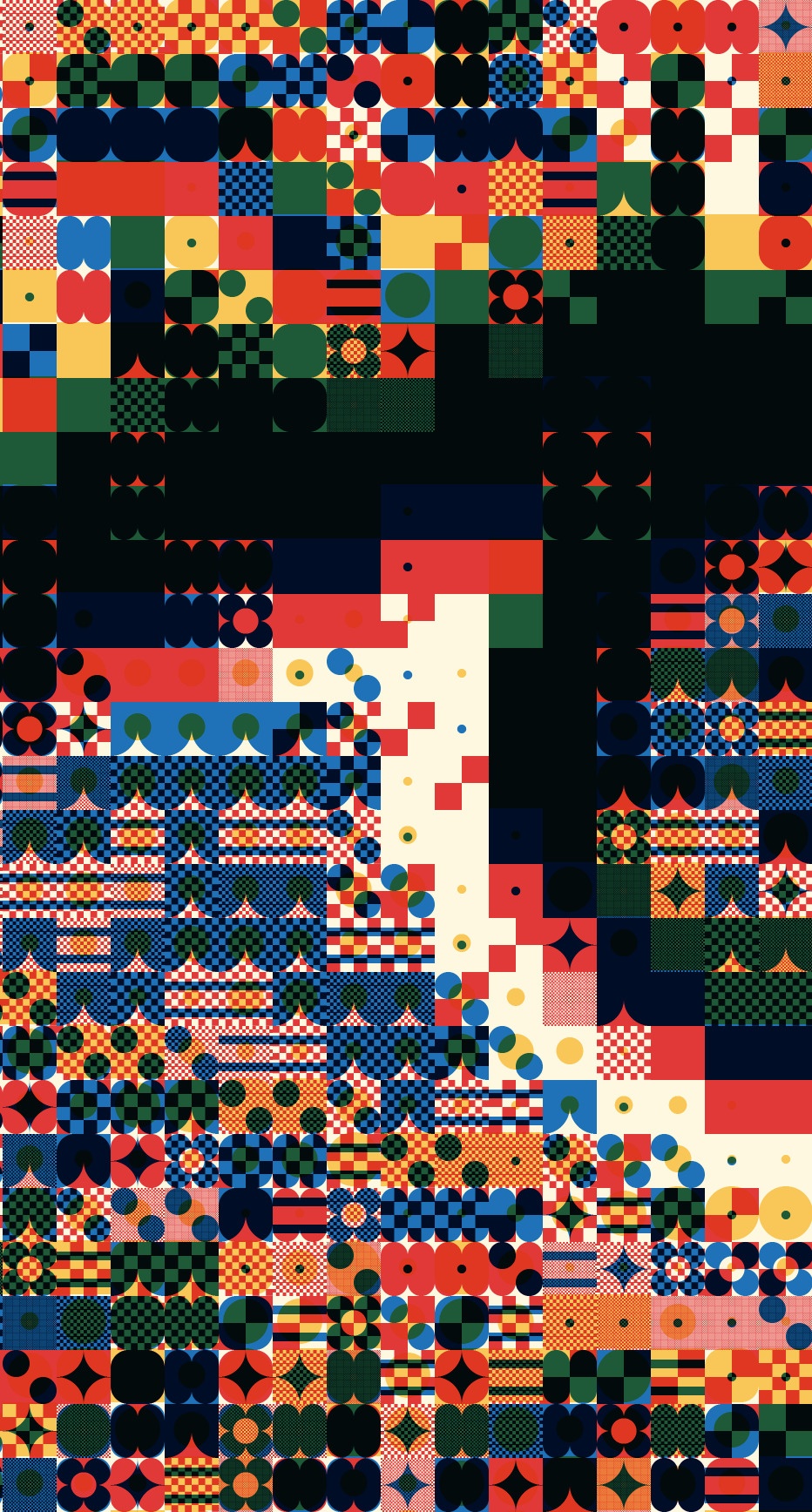
Elemental Test pattern by io Design Company
98 notes
·
View notes
Text
Dissofetish
Pt: Dissofetish :end pt




Banner transcript: 18+ only Minors do not interact 18+ only :End Transcript

A dissomei subterm when an that refers to a disconnect a person feels towards their fetish status or what kinks they do or don't have due to a multitude of possible factors. This is not voluntary, nor does this override external fetish status or what fetish they have and is to merely acknowledge the disconnect.
This could be considered as a subterm to Dissophilia (link) but does not have to be.
Mention / tags: @mogaigonewild, @dissodic-archive, @io-innerself, @tenting-archive

Banner transcript: This term was coined by a kinky asexual endo. Anyone can use (So don't repost or recoin) (Ask before adding to wikis) :End Transcript
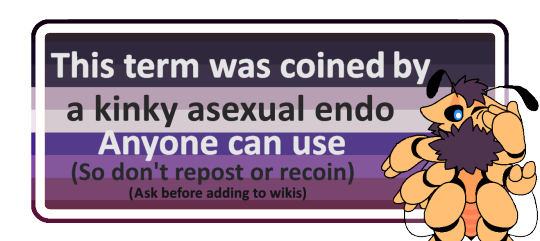

Written flag ids under the cut, same as alt text.
Main flag id: A 9 striped flag with varying thickness and designs. Each stripe has a ruffle or scallop-like design. The design pattern is as follows: a ruffle with two places is pulls in with lines creating “strings”, a uneven scallop pattern, a laced ruffle with 3 bumps repeating, and ruffle with 8 bumps and lines creating “strings”, a non patterned stripe, and a repeat of the first four stripes but in reverse. The colors from too to bottom are: very dark purple, dark purple, purple, dark magenta, magenta, purplish orange, orange, pale-ish orange, light orange. In the center of the flag is the dissomei symbol, a stylized brain, colored pinkish red. It is outlined twice, the outermost being light pink, and the innermost being a darker pink. On the dissomei is the fetish symbol, colored dark red. :end id
Alt flag id: A 9 striped flag with varying thickness and designs. Each stripe has a ruffle or scallop-like design. The design pattern is as follows: a ruffle with two places is pulls in with lines creating “strings”, a uneven scallop pattern, a laced ruffle with 3 bumps repeating, and ruffle with 8 bumps and lines creating “strings”, a non patterned stripe, and a repeat of the first four stripes but in reverse. The colors from too to bottom are: very dark purple, dark purple, purple, dark magenta, magenta, purplish orange, orange, pale-ish orange, light orange. In the center of the flag is the dissomei symbol, a stylized brain, colored pinkish red. It is outlined twice, the outermost being light pink, and the innermost being a darker pink. :end id
Plain flag id: A 9 striped flag with varying thickness and designs. Each stripe has a ruffle or scallop-like design. The design pattern is as follows: a ruffle with two places is pulls in with lines creating “strings”, a uneven scallop pattern, a laced ruffle with 3 bumps repeating, and ruffle with 8 bumps and lines creating “strings”, a non patterned stripe, and a repeat of the first four stripes but in reverse. The colors from too to bottom are: very dark purple, dark purple, purple, dark magenta, magenta, purplish orange, orange, pale-ish orange, light orange. :end id
#in dark times should the stars also go out?#Dissofetish#dissomei#dissodic#Dissophilia#18+ mdni#minors dni#MDNI#mogai after dark#liom after dark#Paraphila Self#term coining#mogai coining#flag coining#mogai term#liom coining#liom term#coining#mogai identity#mogai terms#label coining#liom terms#Liomogai after dark#18+ liom#18+ mogai#After dark mogai#liom label#new mogai term#mogai label#liom identity
21 notes
·
View notes
Note
Is the pack just for clip studio or does it work for others? I use medibang myself.
They're .abr brushes so they're supported by any software that is compatible with ABR. Most of the brushes actually work best in Photoshop due to its unique brush engine (and the fact that many of them were designed for Photoshop first), but can work in both Clip Studio and Procreate as well.
Unfortunately I'm not sure if they'd work in Medibang as IIRC it relies more on a bitmap brush system similarly to IbisPaint, and converting ABR to that kind of format is a lot easier said than done (plus even if it was doable, you'd undoubtedly lose a lot of the core functionality of these brushes).
That said, if you don't have access to an ABR-compatible software, your closest equivalent to the brushes within that pack would be anything that resembles watercolor, gouache, pencil and ink, and impressionist brushes. Those are generally what a lot of those brushes are save for the pattern stamps n such, so even if you can't access those brushes specifically, I'm hoping you could find Medibang-compatible brushes that are close to the real thing so long as you look in the right places !
It is an unfortunate drawback to the nature of these brushes that they were designed for Photoshop first, it means they inevitably aren't going to work in every software. I've looked into converting them in the past but the process would just be way too extensive for me to do on my own and again, it wouldn't guarantee the brushes would even resemble their ABR versions which would defeat the point of trying to convert them in the first place 😅 Still, I hope you're able to find some Medibang equivalents using the tips I mentioned above, and if you want an ABR-compatible software that won't cost you your firstborn like Photoshop, Clip Studio's perpetual license goes on sale at least 2-3 times a year, and Procreate is still incredibly cheap on the iOS store if you have an iPad.
Sorry I couldn't be of more help! Hopefully some day Medibang will be ABR-compatible, Clip Studio wasn't always compatible with ABR either so the odds might be low but they're definitely not zero ! :'0
24 notes
·
View notes
Text


a little wip! it's about time I introduced an oc here other than Aleyxi, so meet Callisto! (and Europa and Ganymede, by extension)
Callisto is what you get when you try to make a werewolf out of someone who is already decidedly canine and anthropomorphic - a wereberus! were-cerebus. Three times as much wolf in your wolf, right there.
...Maybe a bit more than three times as much on occasion. Three heads does mean three times the appetite, after all. Gotta store extra energy for your next transformation, y'know! Go ahead and eat up, you ever know just how much you'll need.
I'm still working out her actual markings/palette, but this gets the main idea across. Europa is the extra head looking at the pie, and Ganymede is the head with both ears folded. Callisto's overall design is going to draw on Jupiter's moons, they're so pretty... and she's good at living up to her namesake.
If anyone's noticed the name pattern and is wondering where Io is, I'll throw some stuff under the cut for you.
I'm still trying to decide exactly how I want to include Io. Io stands out from the other Galilean moons anyway, it's super volcanically active instead of being icy like Ganymede, Callisto, and Europa. It's a monster world.
My current thought is either bellymaw or tailmaw - either way, they wouldn't make appearances all too often. Probably only during transformations when there's an absurd amount of magic around, like lunar eclipses or close to special days like Halloween.


I think I'm really leaning more towards tailmaw at this point. It would even play into some of the myths that describe Cerberus as having snake heads instead of just dog heads, hah. Still just brainstorming it at this point, though. Thoughts and suggestions are welcome!
127 notes
·
View notes
Text
The Belle of the Ball

Dress | Boots | Necklace | Earrings | Bracelet | Hair comb | Gloves | Fan
My HPHL OC Astraea Morgen will wear this at the 1892 Winter Yule Ball, which she's attending with her bestie Io Gordon (OC of the ever-so-talented @drinkyoursoupbitch ). This is for the event organized by @leaping-toadstool-caps
Astraea will wear this breathtaking evening gown that embodies the romantic opulence of the Victorian era. The dress features a stunning combination of golden silk and delicate lace overlay adorned with intricate floral embroidery in soft pink hues. The bodice is masterfully structured with a tight-fitting corseted waist, complemented by ethereal cap sleeves trimmed with exquisite cream-coloured lace.
The skirt is a masterpiece of Victorian design, cascading in elegant golden folds with an elegant bustle and train. The overlay of sheer, embroidered lace creates a dreamy, dimensional effect with its delicate patterns. The dress is accessorized perfectly with period-appropriate golden boots, an ornate decorative fan, and stunning jewelry, including a golden pendant with pink stones, floral diamond earrings, and an elegant hair comb that would have sparkled magnificently in the ballroom lights.
10 notes
·
View notes
Text
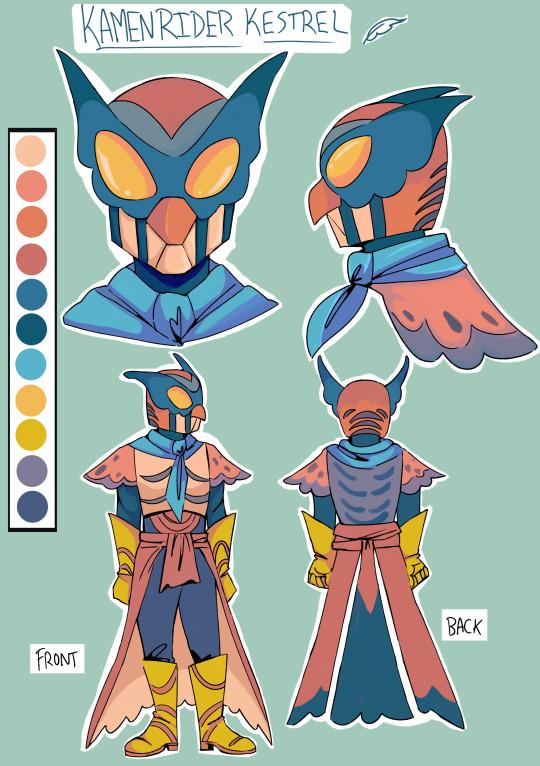


finally finished my designs for my toku suit ocs (: theyre siblings! I dont have much character info on them beyond that, but I really had fun designing these suits
full id under the cut!
[ ID: three digital drawings of original kamen rider and super sentai suit designs. the suits are themed based off of an american kestrel and an io moth.
the first drawing is a character sheet, which shows a front facing view of the suits mask and a side view of the mask near the top of the drawing and a full body front view of the suit and a partial body view of the back of the suit underneath. on the left of the drawing is a color pallette for reference. the suits mask is designed to look like the head of a kestrel, with its colors ranging from light browns to blue and golden. around the suits collar is a blue scarf, and its shoulderpads are stylized to look like brown wings. the breast plate is marked to look like the chest of a kestrel, and around the suits waist is a cape that splits into three parts meant to look like a kestrels tail feathers. both the suits boots and gloves are golden. on the top of the drawing there is text that reads "kamen rider kestrel" in all caps with a small drawing of a feather next to it. next to the full body drawings are text that read "front" and "back" corresponding with each front and back view.
the second drawing is a character sheet which shows two side by side versions of a front facing view of the io moth suit, and then two versions of the back view of the suit. the first front facing view of the suit does not have a cape, while the second does, and the first version of the back facing view has a cape while the second doesnt. the suit is colored in mainly warm hues, ranging from goldens to reds and browns. the suits helmet has large red eyes resembling a bugs and has two fluffy golden antennae. the top of the helmet and around the suits neck are both also covered in golden brown fluff. around the waist of the suit is a short golden cape, with markings similar to an io moths wings. the suits arm braces and boots are both golden. the suits cape is also stylized to look like an io moths wing with two brown circles near the top of the cape. the back of the cape has two layers with circle markings on the bottom layer and curved edges. without the cape the front and back of the chest plate have semi circle patterns near the top and bottom of the armor. there is a color pallette for reference on the bottom of the drawing, and the different full body and partial body poses are labeled with text that reads "front" and "back".
the third drawing shows a closeup of the io ranger suit helmet from the front and the side view. the side view shows that the helmet has similar markings as the suits capes, resembling an io moths wings with a circle and semi circles around it. below the drawings of the helmet is text that reads "moth sentai io ranger" in all caps. there is a small drawing of a moth done in white next to the text. /END ID]
121 notes
·
View notes
Text
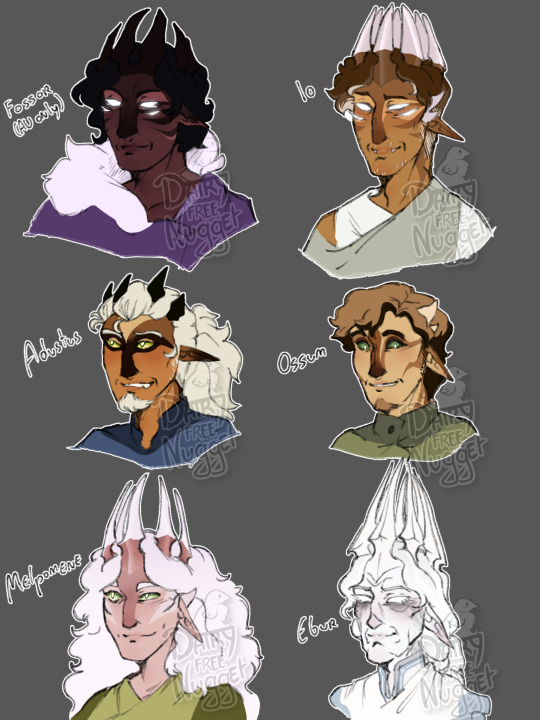
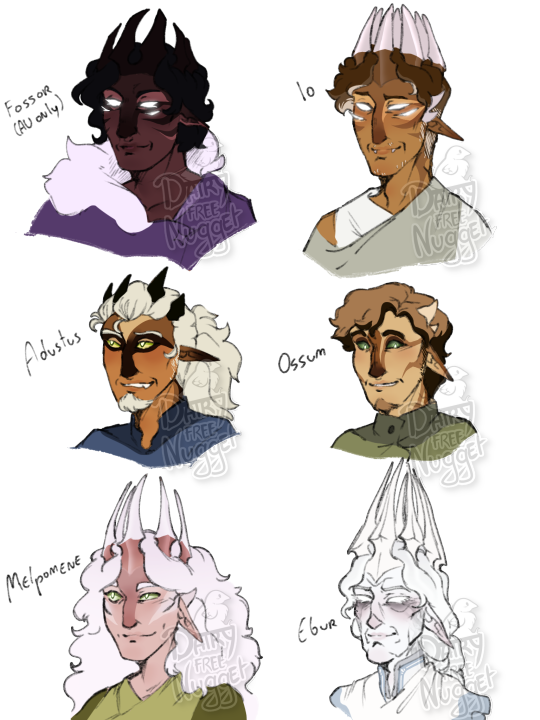
I designed some gijinkas for mine and my friend's ocs that are from the same clutch as PK. Most wyrms are colourful and have patterns, he's Just Like That
I also ordered them from oldest to youngest, which not only makes it look like their mother Adamas ran out of ink but also is hilarious with how old PK looks like
Io and Melpomene belong to @bluethepearldiver
#hollow knight ocs#hollow knight original character#hk ocs#hk oc#hk gijinka#hollow knight gijinka#my art#doodle#spooky arts#faaf au#no id#(will add later i dont have enough spoons rn)#my ocs#oc: fossor#oc: adustus#oc: ossum
30 notes
·
View notes
Text
[Review] Year Walk (Wii U)
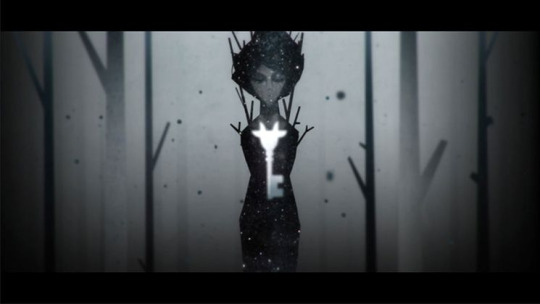
A dark and compelling Scandi fairy tale… now with gyro controls!
After playing Lorelei and the Laser Eyes, I was curious about Simogo's other moody puzzle adventures, especially this one which got an enhanced port to the Wii U. Now of course you can't buy Wii U games anymore, but there are more custom ways, and of course I supported the developer by buying a copy on Steam as well!
Year Walk leans into the developers' Swedish origins by portraying the old folk ritual of årsgång, where by deprivation and quest one might catch a glimpse of the future. This plays out as a short horror-puzzle adventure where you navigate a small forest, gathering clues and encountering dangerous creatures from Scandinavian folklore such as the Brook Horse and Church Grim.

Your surroundings are rendered like a bleak but beautiful watercolour pop-up book. Each screen is a simple 2D line with exits above and below, and occasional things to interact with. Year Walk keeps things fairly simple with the controls, but requires some note-taking to match up patterns and symbols. When you find one of the forest's monsters, things go beyond creepy fairy tale into the territory of jumpscares and slightly disturbing imagery, so be warned.
The ending is especially grim, but a post-credits scene hints at a deeper mystery that reveals a new layer to the story, explored via journal entries from a modern scholar of these cultural practices. I found it interesting, especially with respect to Lorelei which expands on similar concepts.

As a bite-sized but evocative puzzle game with some nice cultural ties it's a nice little package, but I found it rewarding to learn about the game's development history as well. Originally teased and hinted as almost an ARG, it arrived on iOS alongside a companion app with more background on the mythology involved, which does also have some gameplay relevance. A year later it received a computer port, which updates some things, integrates the encyclopedia, and adds a handy map. I found it worked well on Steam Deck with a combination of button and touchscreen controls. The Steam release also uniquely has achievements, some of which act as extra bonus puzzles.
The Wii U version came as a result of Nintendo courting indies in that era, with the porting help of Dakko Dakko. This goes all in on Gamepad features, with lots of gyro and rotation for basic actions, which I found strained my wrists a bit. There's an added interaction or two and certain notes and documents are now presented in Swedish with a translation for enhanced verisimilitude, but the use of the second screen is what makes this the definitive way to play for me, as it enables easy reference of the map, journal, etc. while keeping them separate from the context of the action in the forest. It also adds an in-built note-taking function, and an alternate more involved puzzle to unlock the second ending which even makes use of the normally dry Wii U digital manual!

I don't mind a bit of creepiness but outright horror and frights don't agree with me. But apart from these popping up infrequently, I found this very compelling, even clearing it multiple times for those Steam achievements. Unlike with Lorelei, there's no randomisation in the puzzles so each playthrough is more or less identical, but the game is most effective as a one and done in a single sitting anyway. The art design with its painted style and stop-motion-esque characters is strong and makes for a thick atmosphere; I also saw shades of Sayonara Wild Hearts in the more surreal moments… by the way, you can get that game, this one, and Lorelei in a bundle on Steam you know! They're all very good!
4 notes
·
View notes
Text



Smart Switches: Integrated microcontrollers for diagnostics (e.g., contact wear, cycle count) via IO-Link.
Enhanced Materials: Graphene coatings for lower contact resistance, self-lubricating polymers.
Haptic Feedback: Simulating different "click" feels electronically.
Sustainable Design: Recycled thermoplastics, lead-free plating, extended lifespan focus.
Miniaturization with High Power: Advanced contact materials enabling smaller 20A+ switches.
Custom Illumination: Full RGB LEDs with programmable patterns via embedded drivers.
2 notes
·
View notes
Text

[ID/A dark red line with gold lining and a repeating star and half moon pattern./end ID]
Minecraft zombie piglin flags
[PT/Minecraft zombie piglin flags/end PT]
Minecraft zombie Piglin flags; Othersoul, alterhuman, kin, and otherhearted.




[ID/four rectangular flags of 9 even horizontal stripes with a circle on the center with a symbol on it. The colors go from top to bottom as brown, light pink, pink, dark green, gold, dark green, pink, light pink, and brown. The first flags's center symbol is the othersoul symbol; a thick circle base with a rectangular box and a filled in star. The second flag's center symbol is the alterhuman symbol that resembles an alt symbol; a line and a raised arrow with a free space and a line. The third flag's center symbol is the kin symbol; an upside down seven pointed star. And the fourth flag's center symbol is the symbol of otherhearted; a circle entwined with a heart that has a diamond design on the sweetheart end./end ID]

[ID/A dark red line with gold lining and a repeating star and half moon pattern./end ID]
Requested by @candlesnuff404
Taglist: @io-archival @radiomogai @kin-flags
#: koiran nappulat#alterhuman#otherkith#otherhearted#kith#kin#otherkin#othersoul#mogai#liom community#mogai community#liom label#mogai label#liom safe#mogai safe#mogai blog#mogai term#liom blog#liom term
11 notes
·
View notes
Text
*Jones was adjusting some of the variables for the Blimp's flight path when a ping from his tablet alerted him to an irregularity. Curiously, he picked it up to see which of his sensors had gone off.*
*It was an old IO beacon, that had been unused during the time he had left, which he had commandeered shortly before the Zero War. It was designed to alert as to the looper victory at the end of each individual loop. Originally, it had been so the IO could pick them up and either recruit them or let them wander the island, but Jones had been using it to make sure the loop hadn't been experiencing any irregularities.*
Hmm.
*Oddly, the beacon was saying that there had been no Victor of the previous loop.*
That doesn't make any sense...
*Vocalizing his thoughts, he decided to look over the logs from the past few loops. Then, on a hunch, he expanded his search to loops from over the past few months. And that's when he spotted it.*
*Loops closed every 22 minutes, and there were many in a day. But, almost to a pattern, there were about 100 loops over the past few months that the beacon had registered as having no winner. It was impossible, but either the loop was having issues...*
*Or loopers were going missing.*
*Jones frowned. This clearly required more research. So, he sighed, pulled up the 100 odd abnormal loop files, and began digging.*
4 notes
·
View notes
Text
How iOS Development Companies Leverage Design to Enhance User Experience
In the fast-paced world of mobile app development, user experience (UX) has become a critical factor in determining the success of any iOS application. Whether it’s a simple utility app or a complex enterprise solution, the design and usability of an app directly impact its user engagement, retention, and overall success in the market. iOS development companies are increasingly focusing on leveraging design to enhance the user experience, ensuring that apps are not only functional but also intuitive, visually appealing, and easy to navigate.
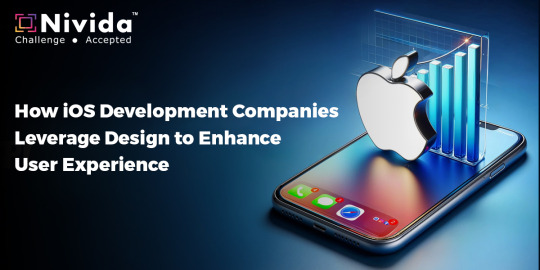
In this blog, we will explore how iOS development companies, particularly the Best iOS Development Companies in Gujarat, are using design principles to enhance user experience, and why design plays such a pivotal role in the development of iOS applications.
The Role of Design in iOS Development:
Design is much more than just the visual appearance of an app. It encompasses how users interact with the app, how intuitive and seamless their experience is, and how easy it is for them to accomplish their goals. A well-designed app creates a positive first impression, builds trust, and encourages users to return. On the other hand, poor design can lead to frustration, confusion, and ultimately, app abandonment.
For iOS development companies, design is a strategic element that influences the app’s usability, functionality, and overall performance. The Best iOS Development Company in Gujarat understands the importance of user-centered design and works to integrate it into every stage of the app development process, from concept to launch.
1. User-Centered Design Approach:
The foundation of great UX design is a user-centered approach. This means designing the app with the end-user in mind, ensuring that their needs, preferences, and behaviors are considered throughout the development process. iOS development companies use various tools and techniques, such as user research, personas, and journey mapping, to gain a deep understanding of the target audience.
By focusing on the needs of users, the Best iOS Development Companies in Gujarat can create apps that are intuitive and easy to use. They conduct user testing to gather feedback and make design improvements, ensuring that the app’s interface is as user-friendly as possible.
2. Simplifying Navigation:
One of the most crucial aspects of iOS app design is navigation. A seamless navigation system ensures that users can easily find what they’re looking for without feeling lost or frustrated. iOS development companies leverage design principles such as hierarchy, consistency, and simplicity to create intuitive navigation systems.
The use of standard iOS design patterns, such as tab bars, navigation bars, and swipe gestures, ensures that users can easily navigate through the app. By adhering to these familiar patterns, iOS developers can create an experience that feels natural and intuitive, reducing the learning curve for new users.
3. Visual Aesthetics and Branding:
The visual design of an app is the first thing users notice when they open it. A clean, aesthetically pleasing design creates a positive first impression and establishes the app’s credibility. iOS development companies focus on creating visually stunning interfaces that align with the brand’s identity and appeal to the target audience.
The use of colors, typography, and imagery plays a significant role in setting the tone and mood of the app. By adhering to Apple’s Human Interface Guidelines, iOS developers ensure that the app’s design is consistent with iOS standards, making it feel familiar and polished. The Best iOS Development Company in Gujarat pays close attention to detail, ensuring that every visual element is aligned with the overall user experience.
4. Optimizing Performance for Better UX:
While design is essential, it’s equally important to ensure that the app performs well. A beautifully designed app that is slow or buggy will lead to a poor user experience and drive users away. iOS development companies focus on optimizing app performance to ensure smooth, fast, and responsive experiences.
Design elements such as animations, transitions, and interactive elements are carefully optimized to ensure they don’t negatively impact the app’s performance. By leveraging the latest iOS development tools and technologies, Best iOS Development Companies in Gujarat ensure that the app runs smoothly on all supported devices, providing users with a seamless experience.
5. Responsiveness Across Devices:
With the wide variety of iOS devices available, including iPhones, iPads, and different screen sizes, it’s essential for iOS development companies to design apps that are responsive and adaptable to various devices. A responsive design ensures that the app looks and functions well on any screen size, whether it’s a small iPhone or a larger iPad.
Responsive design is achieved through techniques such as auto-layouts, flexible grids, and scalable assets. By focusing on creating apps that are responsive, iOS development companies ensure that users have a consistent experience, no matter what device they’re using.
6. Integrating Gestures and Touch Interactions:
iOS devices are known for their touch-based interfaces, and iOS development companies leverage this feature to create more interactive and engaging user experiences. Touch gestures, such as swiping, pinching, and tapping, are integrated into the app’s design to make it more intuitive and interactive.
By incorporating these touch interactions, Best iOS Development Companies in Gujarat create apps that feel natural and responsive to user input. These gestures enhance the overall user experience by making navigation and interactions more fluid and enjoyable.
7. Accessibility Considerations:
An often overlooked aspect of design is accessibility. iOS development companies are increasingly focused on making their apps accessible to users with disabilities. This includes ensuring that the app is usable by individuals with visual, auditory, or motor impairments.
By incorporating accessibility features such as VoiceOver, Dynamic Type, and high-contrast modes, iOS development companies ensure that their apps are inclusive and can be used by a wider audience. Accessibility considerations are not only a legal requirement in some regions, but also an essential part of creating a positive user experience for all users.
8. Continuous Improvement Through Feedback:
Design is an ongoing process, and iOS development companies understand the importance of continuous improvement. After the app is launched, developers gather feedback from users through reviews, analytics, and direct feedback. This feedback is used to make design improvements and updates, ensuring that the app evolves to meet user needs.
By adopting an iterative design process, Best iOS Development Companies in Gujarat can refine the app’s user experience over time, making it more intuitive, efficient, and enjoyable for users.
Conclusion:
In the world of iOS app development, design is a key driver of user experience. The Best iOS Development Companies in Gujarat leverage design principles to create apps that are not only visually appealing but also intuitive, responsive, and easy to use. By focusing on user-centered design, optimizing performance, and incorporating touch interactions, these companies ensure that their apps provide a seamless experience that keeps users engaged and coming back.
Whether you’re looking to develop a new app or improve an existing one, partnering with a top-tier iOS development company can help you create an app that stands out in a crowded market and delivers an exceptional user experience. Design is not just about making things look good; it’s about making them work better for the users.
4 notes
·
View notes